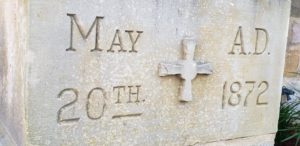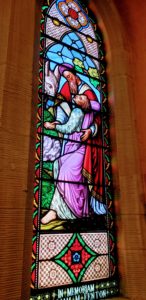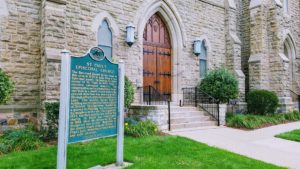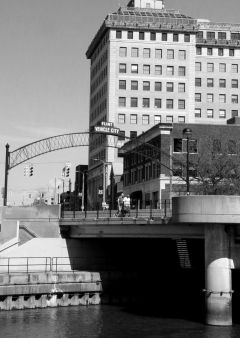By Tom Travis
As the congregation of St. Paul’s Episcopal Church celebrates the 150th anniversary of the laying of the cornerstone in 1872, they also are considering what it means to be “at the intersection” and what kinds of impact the church will and should have in the community.
The Episcopal congregation began worshiping in Flint 182 years ago. The present building, at the corner of Third and Saginaw Streets, is their fourth location. It was constructed 150 years ago.
The anniversary has stimulated the congregation to reflect on their role in the community. That reflection has figured centrally into the church’s anniversary observances, which began last weekend and will last throughout 2022. The congregation has a reputation for ministering to the community but is considering how they can do that better.
“At the intersection” of Third and Saginaw Streets
The phrase “at the intersection” appears in many of the historical pamphlets and documents about the iconic Gothic Revival church edifice. St. Paul’s member and church archivist, Walt Peake, explains that the phrase, “at the intersection” is from a sermon preached by former priest Dan Scheid.
In the sermon, Scheid referred to the church being not just at the intersection of Third and Saginaw Streets, but also at an intersection where wealth and poverty, privileged and marginalized meet.
Peake recalls that the sermon highlighted the physical position and physical space of the church in terms of the social position, and suggested that there are choices to be made at every intersection.
The choices the congregation are faced with are the same choices many congregations face. For example, St. Paul’s has beautiful children’s Sunday school rooms but with the congregation aging, there are very few children. So church members are considering how they can offer those rooms to be used by the community.
With in-person worship beginning again after the COVID shutdown the attendance average is around 30 in the sanctuary that seats 300 The congregation has shrunk over the decades since 1872.
A 1935 fundraising document describes average Sunday attendance was 300. There were over 200 women involved with the Women’s Guild and the Men’s Club have over 150. Over 400 boys and girls attended the church school.
The Parish House, built in 1916, was totally remodeled to accommodate the need for additional space, according to Peake.
Peake adds that peak years in attendance were in the 1950s and 1960s.
Financially, the church has benefitted from the past generosity of many wealthy parishioners. Peake said The finances are secured by more than 100 different trust funds, established by former members who left large sums of money to St. Paul’s.
However, many of these trust funds come with strict rules on how the funds can be allocated. For instance there is one fund with a rule that says the funds can only be used for fresh flowers.
Partners for Sacred Places
To help the congregation make choices about how they minister in the future, St. Paul’s has acquired the services of Partners for Sacred Places (PSP) to help the congregation navigate a process of what it means to be “at this intersection.”
Barbara Mannor, the church’s Senior Warden (she explains, “that’s like the right-hand man to the priest) says that by partnering with PSP the congregation “hopes to discover what the community needs and see how we can fit in and see how we can bring what we have to offer to the community.”
“We know what we can do but we want to make sure it’s what the community needs and wants. Because we’ve been in Flint for so long and being on Saginaw Street, it’s really important for us to continue to have a role in the community,” Mannor said.
The church’s first meeting with PSP will be June 2.
Mannor explains that St. Paul’s already partners with First Presbyterian Church, across the street, along with Court Street United Methodist and Riverside Church to support the ministry Crossover Outreach on Court St. Crossover Outreach assists those in need with food, clothing and services and programs.
St. Paul’s also works with Family Promise of Genesee County, an organization that aims to provide temporary emergency housing for family units so they can stay together during housing challenges.
Mannor says Hamilton Clinic has interest in offering services at the church. Also, before the pandemic shutdown, cooking classes for the community were offered and the church hopes to start those again.
“A Church with Heart in the Heart of the City”
A sign in front of the church states in big bold letters, “A Church with Heart in the Heart of the City.” Peake, the church lay leader, greeted me on the sidewalk outside the heavy wooden doors of the church on a bright spring morning.
As we walked into the church a man was stretched out on the lawn sleeping. Peake said he had checked on the man earlier and he was fine and told Peake that he was “just enjoying the sunshine.” Peake said those kinds of “exchanges” and “relationships” mean a lot to him.
Peake, a retired social worker, said some of the most meaningful moments for him are working with “the neighbors up and down the street.”
Peake says the current congregation is “diverse” with differences in ethnicity, sexual-orientation and gender identity, and professional backgrounds. St. Paul’s offers to the public one service at 9 a.m. on Sunday and a shorter service at 12 noon on Wednesdays. Worship services can be viewed online. Before the pandemic shut down the church, there were two Sunday services.
Tuesday lunch program open for all
Every Tuesday the church offers a lunch program open to anyone in the community. The doors on the south end of the church open at 12 noon. A warm, homecooked meal is served.
During the pandemic shutdown, subs and sandwiches in brown paper sacks were served from the sidewalk by then Priest Dan Scheid.
A full list of ministries at St. Paul’s Church can be viewed here on their website.
A history of St. Paul’s from 1842 to 2022
The congregation of St. Paul’s Episcopal Church in downtown Flint celebrated the 150th anniversary of the May, 1872 laying of the church’s cornerstone in its Gothic Revival edifice this past weekend.

The 150-year-old cornerstone of St. Paul’s Episcopal Church in downtown Flint. (Photo by Tom Travis)
The cornerstone is carved with a Gothic Cross in high relief, and reads May 20th, 1872; but that’s not the day it was laid. That event actually took place nine days later on May 29, 1872, according to Peake.
On Sunday, May 22, at 10 a.m. Bishop Prince Singh along with interim priest Don Davidson, the congregation, and the community gathered to recreate a scene from 1872.

One of the stained glass windows that adorn the sanctuary of St. Paul’s Church. This window is dedicated to William and Adelaide Fenton. (Photo by Tom Travis)
According to St. Paul’s Church history, on May 29, 1872 evening prayer was said in the ‘old’ St. Paul’s Episcopal Church, in a building located about where Blackstone’s Restaurant is now. When the prayer service concluded, the entire community, congregation, bishop, visiting clergy, and the ‘Flint Cornet Band’ marched two blocks south down Saginaw Street to lay the cornerstone at the intersection of Saginaw and Third Streets.
And then 150 years later, on May 22, 2022, the congregation re-enacted the march, and rededicated the cornerstone with Episcopal Bishop Reverend Prince Singh. The congregation gathered in the church’s garden and walked to the cornerstone.
182-year-old congregation celebrates 150-year-old building
Peake said the congregation’s first meeting place was in a rented space on the second floor of a building that’s now long gone in downtown Flint. The new congregation paid $50 a year to rent the room in the 1840s.
Flint wasn’t established as a city until 1855 and many of the new churches in the young city of Flint rented rooms in buildings downtown before formal church buildings were constructed, according to Peake.
Then the congregation built a “shack” downtown, Peake said, near where the State of Michigan building and the University Pavilion are located today. The congregation called this building “the tabernacle” and worshiped there from 1842 to 1843.
Then they built “the first proper church building” as Peake described it, located about where Blackstone’s Restaurant on Saginaw Street is today. The congregation worshiped in there for 30 years from 1842 to 1872.
There were rumblings in the congregation about 1869 and 1870 about the condition of the church building. It was damp and “not a pleasant place to worship,” Peake said.
$8,000 gift “sparked” a wave of generosity
Eliza Simpson Henderson came forward with a gift of $8,000 [according to an inflation calculator, that would be about $175,000 today] to go towards construction of the present St. Paul’s building. Peake explains that Henderson’s generosity “sparked” a wave of generosity in the congregation to build the present building that has housed the St. Paul’s congregation since 1872.
Henderson was the widow of Henry McGregor Henderson who, at the time of his death in 1870, was listed as a banker and merchant. The Hendersons lived in the Third Ward and are buried in Glenwood Cemetery in Flint.

Front doors of St. Paul’s facing Saginaw Street. (Photo by Tom Travis)
The history of St. Paul’s church is filled with the names of iconic and famous Flint-area members, including William and Adelaide Fenton, Franklin and Mary Pierce, J. Dallas Dort, and Flint’s first mayor, Grant Decker.
Those connections are reflected in the stained glass sanctuary windows depicting biblical scenes — many dedicated by Flint’s historical families. One window bears a dedication to William and Adelaide Fenton; he was the city’s fire chief and served on the church’s vestry (church board).
Another stained glass window is dedicated to Franklin and Mary Pierce. It was donated by the Pierce’s son, John, in his parents’ memory. Franklin Pierce developed the area off East Court Street where many things bear his name: Pierce Street, Pierce School and Pierce Park, now the Pierce Nature Conservancy.
The priest just before the church was built was the Rev. Daniel Ebenezer Brown. Sadly, Brown died in August 1873 and did not live to witness the opening of the new building less than three weeks later. The funeral for Rev. Brown was the very last service held in the old building. Rev. Brown is buried at Glenwood Cemetery in Flint.
The architect of the new building was Gordon W. Lloyd of Detroit. Peris F. Cleveland was the contractor and builder. Cleveland died in November 1902 and is also buried at Glenwood Cemetery. The first service held in the present building was on August 24, 1873, according to church history documents.
According to church archivist Peake, the construction cost $26,000 in 1872, not including the exterior stone. John Sutton, who owned a quarry in Flushing, donated 400 cord but with one condition, that the parishioners had to get the stone from the quarry to the construction site.
The stone was brought from Flushing to the construction site during the winter of 1871 and 1872. How the stone was brought to Flint is unclear but there are stories of some of it being floated on barges down the Flint River. The stone is a type of sandstone that becomes more durable over time, Peake explained.
Far above the cornerstone is the bell tower that can be seen from many vantage points throughout downtown. It rises 90 feet and houses four bells. The oldest bell was cast in West Troy, NY in 1845 at a cost of $200.
The cross atop the spire was hand forged by William A. Paterson in his blacksmith shop located just across Third Street, The large oak exterior doors were donated by R. Spencer Bishop and Katherine Bishop Miner, children of Arthur Giles Bishop).
For more information about St. Paul’s Episcopal Church or to schedule a tour, email the office at intersection150@stpaulschurchflint.com. The church is on Facebook at St. Paul’s Episcopal Church and their website is www.stpaulschurchflint.com.
EVM Managing Editor Tom Travis can be reached at tomntravis@gmail.com.


You must be logged in to post a comment.